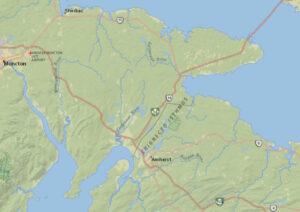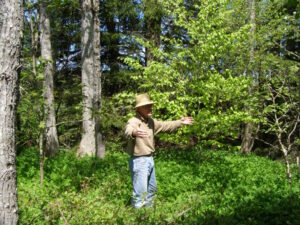The Chignecto/Sikniktewaq Isthmus

Keeping Chignecto/Sikniktewaq Connected
The Chignecto / Sikniktewaq Isthmus, connecting the provinces of New Brunswick and Nova Scotia, is a vital piece of land which requires special conservation measures.
The Isthmus is a narrow, 24 kilometre strip of land that joins mainland Nova Scotia to New Brunswick and the rest of the continent. It has two distinct coasts – to the northeast is the Northumberland Strait and on the southwest is the Bay of Fundy. The towns of Amherst, NS and Sackville, NB are located on the Isthmus itself.
The Isthmus is an important transportation corridor with the Trans Canada Highway and inter-provincial railway crossing over it. It is also the only route for terrestrial wildlife to move in and out of Nova Scotia.
Without deliberate planning to conserve ecosystem connectivity, development on the Isthmus could restrict the natural movement of plants and wildlife across this important land bridge.

If we keep putting up barriers to wildlife movement and we decrease “ecological connectivity”, it will limit the ability of plant and wildlife populations to respond to a changing climate. Fragmentation of natural habitats can be caused by the combined effects of roads, railways, agriculture, residential development and intensive forestry management.
A Priority Place for Wildlife Conservation
Because of the ecological significance of the region, the Isthmus was selected as a Community-Nominated Priority Place (CNPP) as part of Canada’s Nature Fund. CPAWS NB is taking part in conservation efforts to address some of the threats to wildlife on the Isthmus. The purpose of the Chignecto/Sikniktewaq Partnership is to bring together a diversity of views to create a plan to conserve Species at Risk (SAR), habitats and Indigenous cultural heritage of the Chignecto Isthmus.

The Chignecto/Sikniktewaq Partnership includes biologists, conservationists, government experts, environmental non-government organizations, and representatives of Indigenous communities. Together, we are pooling our knowledge to identify how we can best conserve cultural connections and wildlife in the region.
View our Storymap to learn more about the issues facing the area.
We Need More Protection on the Isthmus
A few areas on and beside the Isthmus are protected for conservation. As natural anchors for connectivity, the Canaan Bog Protected Natural Area (NB) is located to the northwest and the Chignecto Game Sanctuary (NS) to the south-west.
CPAWS and the Cumberland Wilderness Society have called for increased protection of public land in the area for many years. We helped create provincial protected areas such as the Chignecto Isthmus Wilderness Area, which includes the drinking water supply area for the Town of Amherst. These areas along with the Tintamarre National Wildlife Area are permanent refuges for wildlife.

However, these protected areas are too few and too far apart.
To sustain wildlife on the Chignecto/Sikniktewaq Isthmus into the future, we need to:
- Create more protected stepping stones of habitat throughout the corridor, in New Brunswick and Nova Scotia.
- Use community land use planning to make sure wildlife habitat is included in development decisions.
- Ensure forests are managed to conserve old forests and healthy stream banks so wildlife will always be able to find the room they need to roam for food, mates, and shelter.
Further Reading
- Chignecto Connectivity Report – A report written by CPAWS NB and CPAWS NS in 2005, outlining opportunities for conserving connectivity across the Chignecto Isthmus. (Full report 5Mb)(Executive summary 470 kb)
- Fact Sheet – The Chignecto Isthmus: Keeping it Connected (pdf)
- Fact Sheet – Forest Fragmentation and Ecological Connectivity on the Chignecto Isthmus (pdf)
